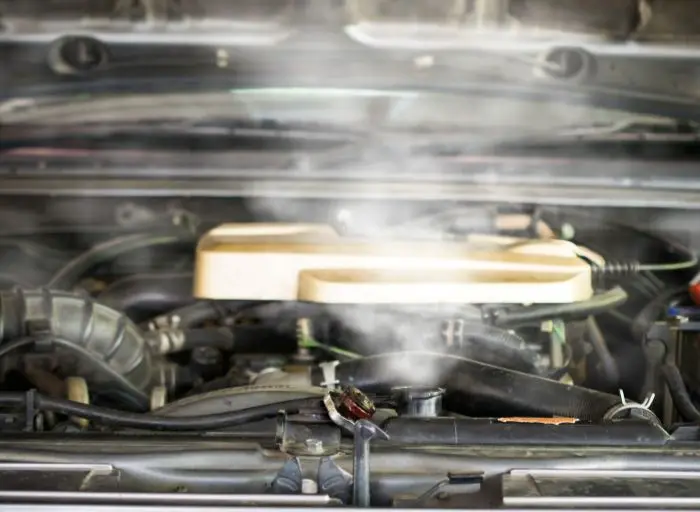
One of the most common ways cars get themselves into trouble is due to overheating, which causes the engine to overwork, decrease power output, and ultimately stop working altogether. If you’ve ever seen your car’s temperature spiking well above normal levels while driving on a long highway, take heed. It might be time for a cooling-off break before things go south. So, how far can you drive an overheating car?
The short answer is that there is not a specific amount of miles you can travel with an overheating engine. The car will shut off when a part stops working. While one can travel an extra 2 miles, others can drive for a longer distance. However, I suggest you shouldn’t drive more than a quarter mile with an overheating car.
Table of Contents
What is an Overheating Car?
An overheating car is a vehicle whose engine has become too hot. This can be caused by a number of different issues, such as low coolant levels, a faulty thermostat, or a restriction in the coolant system.
When an engine starts to overheat, its temperature rises beyond the normal operating range and can lead to serious damage to the internal components.
Symptoms of an overheating car include steaming from the hood, a radiator cap that pops off due to pressure buildup and ill-functioning cooling fans. If left unchecked, engines can experience head gasket failure and catastrophic seizure due to extreme temperatures resulting in significant repair costs for drivers.
How Far Can You Drive an Overheating Car?
As mentioned above, we can’t give an exact figure here, and it all depends on the engine itself. You can continue to drive your car up to about 30 miles if your engine starts to overheat. It is said that the temperature of the water in the cooling system can get up to 95 degrees, which is just another pointer towards an overheating engine.
The main reason why people think their car will stop driving once it’s overheating is that many people have heard or seen individuals driving for a long period of time with an overheated car. That doesn’t mean the car will stop driving, even if the engine temperature is getting too high.
What happens is that the engine may start working more slowly, but it’s virtually impossible to say that the motor has given up on you. And that, really, is just fine with most drivers just yet. It all comes down to how you feel about your car and its performance once it reaches certain levels of temperature.

Since it is hard to distinguish hot water from cool water, the best thing to do is to simply wait until you can personally check out the discharge temperature. Most of all, the best way to avoid such a scenario is to get a visual clue. If you can see steam coming out from under your hood, then there’s no doubt that your car will start losing its cool soon.
The truth is that most drivers have driven cars with an engine that is too hot. As a matter of fact, driving a car for a longer period of time can consistently increase the water temperature up to 97 degrees.
It is impossible to tell how far the car can drive before it blows up or stops working, so it’s important to be extra careful when you see those warning signs arise.
There are also those individuals who argue that you can continue to drive your car as long as the temperature remains below 100 degrees. But, as a matter of fact, the temperature gauge is likely to blow at that point. The problem here is that you don’t know whether or not that temperature gauge is reliable.
So the bottom line here is that you should never feel as though you can’t drive your car after it starts to overheat, as long as you have a way of cooling it off quickly. Car engine overheating happens quite often.
How To Cool Down The Overheating Engine Quickly
#1 Give Your Car 30′ Break

One of the main ways to cool off an overheating engine quickly is to stop your car. If your car is overheating on the road, you can stop for a few minutes by pulling over to the side of the road or by parking your car in a safe place. Check both tires and rims for any mechanical damage. Turn off all electrical accessories, like headlights and ventilation fans. You can also wait until your engine cools down so you won’t get heatstroke.
#2 Check Car Coolant Levels

If you have a radiator cap, open it and wait for the car to cool down. If the coolant level is low, then you need to add more coolant. If you don’t have any coolant, then you need to find some in a service station or auto parts store. You can ask for help from the staff when they are open. Wipe off any excess oil in the engine bay with a rag. Add the coolant slowly until it overflows from the overflow tank.
- CONTAINS ALUGARD PLUS FOR COMPATIBLITY WITH ALL...
- FIGHTS CORROSION, SCALING AND RUST while...
- HIGH-QUALITY ADDITIVES PROTECT AGAINST LEAKS and...
#3 Turn Off The AC

If you have an air conditioner, then turn them off, and let the car cool down. You can then turn it back on after a short while. This will allow the cooling system to cool down faster.
What Damages Can Be Caused By Car Overheating?
Cars with overheating engines can suddenly fail at any time if a piece of metal or a gasket breaks. This creates a hole in the engine’s coolant system and coolant will run out of the car. The hot engine also causes the radiator to overheat, which makes it shatter from extreme pressure.
Overheated engines can also cause some expensive problems as well as serious safety issues for you and your passengers. An overheated engine can damage the engine block and the cylinder. The pistons and other parts inside the block may break as well.
Pipes, hoses, and gaskets close to a hot engine may also crack or burst. This means coolant leaks from everywhere. Engine pours out of your car’s hood, creating a strong possibility of a fire inside your car. This is why you should never drive an overheating car too far.
Signs Of Overheating Vehicle Engine
When your car is overheating, then there are several signs that will let you know that something is wrong.
The indicators are simple enough, but it’s worth paying extra attention to. You’ll notice they do not change in a predictable or regular pattern. It could be the engine itself is warming up to a normal temperature, or it could be that temperatures are high due to internal damage.
- Usually, when your car is overheating, the engine seems to have problems starting. This is because it’s not getting enough fuel when it needs to get going.
- One thing you should always check when getting into the car is the temp gauge. If the gauge is in the red zone, your car is overheating. If it’s in yellow, then your car needs to cool down.
- In a worse scenario, you’ll see steam coming from the engine bay.
There are also those individuals who claim that their car is overheating because their cooling fan isn’t working. The most common reason why the cooling fan may not be working correctly is that it’s not getting enough electrical power. Make sure that your battery’s charge is high enough to ensure the correct operation of all accessories, especially the cooling fan.
How Should You Handle an Overheating Car?
When your automobile starts to overheat, carefully stop (if you’re driving) and switch off the engine. Then, take a deep breath, be patient and follow these steps:
- Call roadside assistance and report the situation.
- Allow your car to cool down before checking anything under the hood or trying to find the source of the issue.
NOTE: If you open the radiator cap before the engine has cooled off, you run a significant danger of suffering serious burns.
- Look for any coolant leaks under the car and around the engine, radiator, and coolant lines.
- Open the radiator cap and check the coolant level if you’re confident that the cooling system has cooled down sufficiently (after waiting at least 15 minutes).
What Is The Cost To Repair An Overheated Engine?

An overheated engine may require expensive repairs. These kinds of minor fixes typically cost between $200 and $400.
However, you’ll have to pay significantly more for repairs if your overheated engine caused a blown radiator, damaged pistons, or damaged cylinder heads.
You can anticipate paying roughly (These estimations count for both labor and parts)
- Replacement of a cylinder head costs $1,350
- Head gasket replacement: $1,985
- Radiator replacement costing $1,050
How To Prevent Your Car From Overheating?
As discouraging as it may sound, there is no surefire way to prevent your car from overheating. But you can at least make sure that your car stays cool inside. The best way to do this is to get a fan.
There are some cars today that have built-in fans for this sole purpose, but more often than not, they are not enough. In addition, it is also very important to get a radiator cap or hose clamp. A radiator cap protects the cooling system from overheating by limiting how much coolant can flow through the pipes.
The hose clamp helps to prevent leaks. Some cars use a hose clamp instead of a radiator cap, which isn’t as effective as a radiator cap. If you have a car with a leak in the cooling system, then you should check the hose clamps and replace them if necessary.
- Superb Material: Our adjustable hose clips are...
- Perfect Hose Clips Set: The automotive hose clamps...
- Easy to Use: The stainless steel pipe clamp...
Another important thing about car cooling is that there must be enough airflow through the vents in your car. If you observe that the air is not flowing through the vents, then you can fix it by using a vacuum cleaner. This will suck some of the hot air out of your car and keep it from ruining your engine and other parts.
FAQs
#1 Can I drive my car if it’s overheating?
If your car is overheating, it is not advised that you drive. Driving your automobile while it is overheating can seriously harm your engine and other parts, costing you money in repairs or even resulting in engine failure. Before continuing to drive, it’s crucial to turn off the engine and give it time to cool down. If necessary, you should also seek a mechanic’s help.
#2 How long can a car overheat before damage?
A car can overheat for an extended period of time before any permanent damage occurs, however, the amount of time depends on a variety of factors. Generally speaking, a car can overheat for up to 20 minutes before experiencing any serious engine issues.
However, it is important to note that the longer a car is allowed to overheat, the more likely it is that various components such as the radiator and water pump will begin to suffer from irreparable damage. As such, it is important to take preventative measures prior to and during driving in order to avoid unnecessary damage.
#3 How far can you drive with low coolant?
The exact amount of time you can drive with low coolant will depend on several factors, including the type of vehicle you have and the temperature outside.
Generally speaking, however, it is recommended that you don’t attempt to drive any further than necessary if your coolant levels are below the recommended level. Driving with low coolant could lead to serious engine damage due to overheating, which can cause major mechanical issues or even cause total engine failure.
Furthermore, if coolant levels become too low, it can cause a lack of lubrication within the cooling system leading to friction-related parts breakdown and a possible seizure of an engine’s components.
Conclusion
The best course of action if your car’s engine is overheating is to stop driving as soon as you can to avoid things getting worse. It is not always simple to stop right away, therefore you might be curious about how far an overheating car can be driven.
When an automobile engine overheats, there is no limit to how far you can continue to drive, but it is best to stop as soon as it is safe to do so.
Still keen for more info. Check this out, my friend.
Further Reading:
- Advice for overheating car from AAA
- Ways to stop an overheating engine
- Ways to diagnose a cooling system problem
Hi there! I’m Naomi O’Colman. I’ve got years of experience working at an auto repair shop here in Texas under my belt. On top of that, ever since I was a kid I’ve been passionate about the auto industry. Since I’ve joined the team at automotivegearz.com I’ve been enthusiastically sharing my passion and insights with my readers. I’m dedicated to delivering high quality content and helping you stay up to date with the latest automotive trends and products out there!









